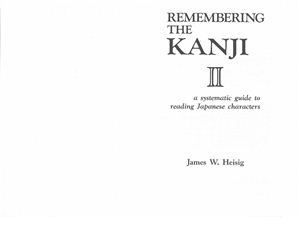Издательство: japan publications trading Co., Ltd. James W.
Heisig.
Part 1. 1977г. -552c
Part 2. 1987г. -199c
Part 3. 1990г. -491c
The aim of this book is to provide the student of Japanese with a simple method for correlating the writing and the meaning of Japanese characters in such a way as to make them both easy to remember. It is intended not only for the beginner, but also for the more advanced student looking for some relief to the constant frustration of forgetting how to write the kanji and some way to systematize what he or she already knows. By showing how to break down the complexities of the Japanese writing system into its basic elements and suggesting ways to reconstruct meanings from those elements, the method offers a new perspective from which to lea the kanji.
There are, of course, many things that the pages of this book will not do for
you. You will read nothing about how kanji combine to form compounds. Nor
is anything said about the various ways to pronounce the characters. Furthermore,
all questions of grammatical usage have been omitted. These are all matters
that need specialized treatment in their own right. Meantime, remembering
the meaning and the writing of the kanji—perhaps the single most dif?cult
barrier to leaing Japanese—can be greatly simpli?ed if the two are isolated
and studied apart from everything else.
Part 1. 1977г. -552c
Part 2. 1987г. -199c
Part 3. 1990г. -491c
The aim of this book is to provide the student of Japanese with a simple method for correlating the writing and the meaning of Japanese characters in such a way as to make them both easy to remember. It is intended not only for the beginner, but also for the more advanced student looking for some relief to the constant frustration of forgetting how to write the kanji and some way to systematize what he or she already knows. By showing how to break down the complexities of the Japanese writing system into its basic elements and suggesting ways to reconstruct meanings from those elements, the method offers a new perspective from which to lea the kanji.
There are, of course, many things that the pages of this book will not do for
you. You will read nothing about how kanji combine to form compounds. Nor
is anything said about the various ways to pronounce the characters. Furthermore,
all questions of grammatical usage have been omitted. These are all matters
that need specialized treatment in their own right. Meantime, remembering
the meaning and the writing of the kanji—perhaps the single most dif?cult
barrier to leaing Japanese—can be greatly simpli?ed if the two are isolated
and studied apart from everything else.

